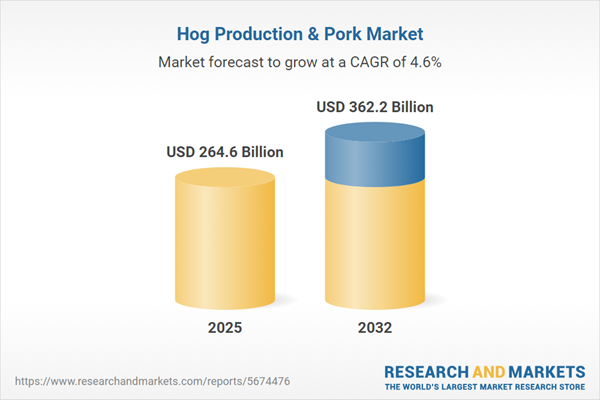Speak directly to the analyst to clarify any post sales queries you may have.
The hog production and pork market is encountering a pivotal transformation, driven by evolving consumer demands, technological breakthroughs, regulatory circumstances, and a growing emphasis on supply chain resiliency. Senior executives navigating this sector face shifting priorities that require strategies built on data, adaptability, and sustainable business practices.
Market Snapshot: Hog Production & Pork Market Size and Growth Trajectory
The Hog Production & Pork Market grew from USD 252.96 billion in 2024 to USD 264.60 billion in 2025. It is expected to continue growing at a CAGR of 4.58%, reaching USD 362.20 billion by 2032.
Scope & Segmentation
- Farming Method: Conventional, Free Range, Organic
- Product Type: Fresh Pork (Belly, Ham, Loin, Shoulder), Processed Pork (Bacon, Ham Products, Sausages)
- Distribution Channel: Foodservice (Full-Service Restaurants, Hotels/Catering, Quick-Service Restaurants), Online (Direct-to-Consumer Sites, E-commerce Platforms), Retail (Convenience Stores, Specialist Butchers, Supermarkets/Hypermarkets)
- Packaging Format: Bulk, Frozen Packs, Retail-Ready Packaging, Vacuum-Sealed Packaging
- Geography: Americas (United States, Canada, Mexico, Brazil, Argentina, Chile, Colombia, Peru), Europe, Middle East & Africa (United Kingdom, Germany, France, Russia, Italy, Spain, Netherlands, Sweden, Poland, Switzerland, United Arab Emirates, Saudi Arabia, Qatar, Turkey, Israel, South Africa, Nigeria, Egypt, Kenya), Asia-Pacific (China, India, Japan, Australia, South Korea, Indonesia, Thailand, Malaysia, Singapore, Taiwan)
- Company Coverage: WH Group Limited, JBS S.A., Tyson Foods, Inc., Charoen Pokphand Foods Public Company Limited, Danish Crown A.m.b.A, BRF S.A., New Hope Liuhe Co., Ltd., Vion Food Group B.V., Hormel Foods Corporation, Marfrig Global Foods S.A.
Key Takeaways for Senior Decision-Makers
- Diversifying production systems is increasingly essential, as sustainability and animal welfare drive premiumization and differentiation within pork supply chains.
- Technological advancement—including real-time health monitoring and blockchain-enabled traceability—enhances food safety, operational efficiency, and consumer trust across markets.
- Producers are responding to regulatory and consumer shifts by adopting practices that prioritize environmental responsibility, such as renewable energy infrastructure and precise feed management.
- Collaborations across the value chain, including feed suppliers, processors, and logistics partners, are streamlining workflows and supporting demand-driven production planning.
- New product and packaging formats, such as health-forward prepared meats and retail-ready packaging, are capturing demand from shifting protein preferences and evolving retail trends.
- Regional variations, including regulatory standards and consumption habits, require tailored market entry and branding strategies to ensure relevance and competitiveness.
Tariff Impact: 2025 Adjustments Reshaping Market Strategy
Changes to pork import and export tariffs in 2025 have influenced sourcing, production planning, and international supply routes. Companies are recalibrating procurement and logistics to address cost fluctuations, optimize shipping routes, and meet evolving consumer expectations in both high-growth and restricted markets. Flexibility in supply chain models is now vital to manage input volatility, while investment in analytics tools supports proactive market planning.
Methodology & Data Sources
This report integrates primary research through executive interviews and industry expert consultations with comprehensive secondary data review of journals, filings, and company disclosures. Key trends and drivers are validated through rigorous frameworks, consensus review, and multi-source cross-referencing to ensure actionable insights.
Why This Report Matters: Direct Benefits for Decision-Makers
- Gain a multi-dimensional view of global and regional opportunities by understanding key drivers that shape operational decisions in hog production and pork markets.
- Apply segmentation insights to inform focused investments, from sustainable production to packaging innovation and regional expansion.
- Assess the impact of technological and regulatory changes and design adaptive supply chain strategies for long-term resilience.
Conclusion
Leaders positioned for future growth will embrace digital transformation, sustainability, and agile operations. This report provides the strategic intelligence necessary to inform critical decisions and guide successful initiatives within the dynamic global pork industry.
Additional Product Information:
- Purchase of this report includes 1 year online access with quarterly updates.
- This report can be updated on request. Please contact our Customer Experience team using the Ask a Question widget on our website.
Table of Contents
3. Executive Summary
4. Market Overview
7. Cumulative Impact of Artificial Intelligence 2025
Companies Mentioned
The companies profiled in this Hog Production & Pork market report include:- WH Group Limited
- JBS S.A.
- Tyson Foods, Inc.
- Charoen Pokphand Foods Public Company Limited
- Danish Crown A.m.b.A
- BRF S.A.
- New Hope Liuhe Co., Ltd.
- Vion Food Group B.V.
- Hormel Foods Corporation
- Marfrig Global Foods S.A.
Table Information
| Report Attribute | Details |
|---|---|
| No. of Pages | 183 |
| Published | October 2025 |
| Forecast Period | 2025 - 2032 |
| Estimated Market Value ( USD | $ 264.6 Billion |
| Forecasted Market Value ( USD | $ 362.2 Billion |
| Compound Annual Growth Rate | 4.5% |
| Regions Covered | Global |
| No. of Companies Mentioned | 11 |









